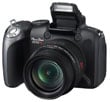Canon PowerShot SX1 IS
-
-
Written by Gordon Laing
Canon PowerShot SX1 IS vs PowerShot SX10 IS vs EOS 450D / XSi
Canon PowerShot SX1 IS results
High ISO noise

 |
 | To compare noise levels under real-life conditions we shot this scene with the Canon PowerShot SX1 IS, PowerShot SX10 IS and Canon EOS 450D / XSi within a few moments of each other using each of their ISO settings. The lenses on each camera were adjusted to deliver the same vertical field of view. The image left was taken with the Canon PowerShot SX1 IS at 7.4mm f3.2 and with a sensitivity of 80 ISO; the original JPEG measured 3.67MB. The crops are taken from an area just to the right of the centre and presented here at 100%. |
Note the Canon 450D / XSi captures wider 3:2 aspect ratio images, so by matching the vertical field of view, we’re effectively treating the DSLR here as a 10.8 Megapixel camera, delivering 4:3 shaped images.
At first glance, the PowerShot SX1 IS appears to deliver essentially the same results as the SX10 IS throughout its ISO range, despite their different sensor technologies. At 80 ISO both cameras are delivering clean, sharp, detailed images, while at 100 ISO, pixel peepers may notice a small amount of noise creeping-in, but nothing to worry about.
At 200 ISO, both PowerShots exhibit more apparent noise textures and a slight drop in ultimate detail, but they’re still respectable. Increased to 400 ISO, both cameras show a noticeable drop in quality and increase in noise when viewed at 100%. It’s best reserved for smaller prints and viewing at reduced sizes on-screen. At 800 ISO, there’s another big drop in quality and increase in noise and processing artefacts.
At 1600 ISO both cameras are suffering, while at the 3200 ISO scene preset, the reduction to two Megapixels results in a significant loss of detail.
So far, so similar, but take a closer look and dedicated pixel peepers may notice slightly higher noise levels from the CMOS-equipped SX1 IS than the SX10 IS throughout the ISO range. Noise artefacts are more visible on the SX1 IS samples if you’re really looking, but it’s subtle, and in our view far from a deal-breaker if you can exploit the other benefits the CMOS sensor brings. This is of course a personal choice though.
Many of you will also be weighing-up the Panasonic Lumix FZ28, and you can see how it compares against the SX10 IS in the same location – albeit on different days with different flower arrangements – in our full review of that camera. Overall we’d say the PowerShot SX10 IS and SX1 IS enjoy a slight edge over the FZ28 in this test thanks to their punchier processing and lower noise reduction. Their crops at lower sensitivities are slightly better defined than the Panasonic, but it’s by no means a decisive win in this test – both cameras are pretty close here.
We’ve also included samples from Canon’s EOS 450D / XSi to illustrate the high ISO benefits of a DSLR over a compact or super-zoom with a small sensor. All three cameras here may deliver clean output at 100 ISO, but as the PowerShots begin to fall apart at higher sensitivities, the DSLR holds it together. So once again if you want the best quality at high ISOs, a camera with a large sensor is the way to go.
Now for more real-life examples across its sensitivity range, check out our Canon PowerShot SX1 IS sample images page.
Canon PowerShot SX1 IS |
Canon PowerShot SX10 IS |
Canon EOS 450D / Rebel XSi | ||
 |
 |
 | ||
80 ISO |
80 ISO |
80 ISO not available | ||
 |
 |
 | ||
100 ISO |
100 ISO |
100 ISO | ||
 |
 |
 | ||
200 ISO |
200 ISO |
200 ISO | ||
 |
 |
 | ||
400 ISO |
400 ISO |
400 ISO | ||
 |
 |
 | ||
800 ISO |
800 ISO |
800 ISO | ||
 |
 |
 | ||
1600 ISO |
1600 ISO |
1600 ISO | ||
 |
 |
 | ||
3200 ISO (at 2 Megapixels) |
3200 ISO (at 2 Megapixels) |
3200 ISO not available |




